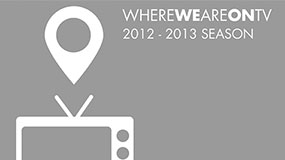
 The Gay & Lesbian Alliance Against Defamation (GLAAD) released their annual Where We Are On TV report for the 2012-13 season on October 5, a report which tracks LGBT and racial representation on U.S. television.
The Gay & Lesbian Alliance Against Defamation (GLAAD) released their annual Where We Are On TV report for the 2012-13 season on October 5, a report which tracks LGBT and racial representation on U.S. television.
The report finds that 4.4% of regularly appearing characters on broadcast television are openly lesbian, gay, bisexual, or transgender (a dramatic increase over last year’s 2.9%), while 22% of characters are people of colour. There is, of course, much overlap between the two groups—30% of LGBT characters are also people of colour.
As regards cable television, no percentage statistics are given, but the report finds that 61 characters represent LGBT persons, and 13 (21%) of those characters are people of colour.
With respect to persons with disabilities, the report is critical of the much lower than average representation rates found on broadcast TV. Only 0.6% of characters have apparent disabilities, while the U.S. Census Bureau reports that as much as 12% of American citizens do.
It is important to keep in mind that the statistics provided by this report are purely quantitative, not qualitative. The report itself does not examine the nature of these characters—it is only concerned with whether or not they are there.
Whether or not there exists characters representative of certain groups in a show does not necessarily imply that those shows are free from stereotypical representations of those groups. For example, Max from Happy Endings is mentioned in this report only in passing, but is a character who resists and subverts many stereotypes affecting gay men. Glee, however, is given its own paragraph, and is the show most talked about in media coverage of this report, despite the fact that it is often criticized by LGBT groups for its stereotypical and occasionally harmful depictions of LGBT folks.
The report also mentions Roger from American Dad as an example of LGBT representation. It is unclear, but he might also represent one of the LGBT “persons of colour” as well. An “omnisexual” alien certainly isn’t who comes to mind when I think of positive LGBT representation.
Little to no attention is drawn to actual LGBT actors or television personalities either. Talk show hosts such as Anderson Cooper (Anderson Live) and Sara Gilbert (The Talk) are mentioned, but no mention is made of actors like Jim Parsons (Sheldon from Big Bang Theory) who are gay but don’t play gay characters.
A more qualitative report—the Network Responsibility Index—will be available from GLAAD at the end of this year’s television season which will feature observations and recommendations.

